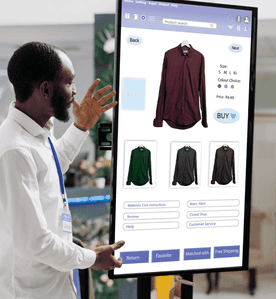Is Your Product Ready to Move from MVP to Full Scale?
Sector: Digital Product
Author: Nisarg Mehta
Date Published: 03/21/2023

Contents
The Perfect MVP Launch Model
It is evident that small businesses can test out new ideas, products, or services in the real world using MVP strategies.
Small businesses with limited resources and tiny startups can benefit from this approach, as this allows the entrepreneur to evaluate the effectiveness of various ideas within a miniature version of the final product.
Suppose you want to start a small restaurant business and offer deliveries to households in several areas. Without knowing how many orders you might receive, starting out with an expansive route right away may be detrimental. However, you may establish certain limitations, such as delivering to popular locations only during the evenings. This will allow the company to develop naturally without stripping the budget right away.
There is one thing certain about the MVP launch model: no matter what type of business you have, you must have the drive and motivation to move forward.
We won’t go more deep into the best practices for MVP and all. If you’re interested, you can read our previously written blog: What is MVP? 5 Benefits of Building an MVP for Your Product
So, what happens after you’ve built the MVP?
Scale Your MVP when the Learning Process is Done

The greatest benefit of using an MVP, in the long run, is what you discover from operating with one. MVP is a research project on the hoof, as it were. It allows you to figure out whether your business has the potential for success and expansion.
You should collect as much data as possible during the initial launch. Know who your customers are? What are they purchasing? What do they think of it? What would they change? What do they love or hate about your product or service? Create a feedback loop to build on to the next step.
It’s important to evaluate how much of a feedback loop affects your actions. For example, you can assess which aspects of your product and service have the highest conversion rates when you first begin to receive customers. Then compare that with the comments of your users.
You got your answer; the only sign for you to scale your MVP is when you think you know your customer needs and are sure about your product positioning in the market.
If you want to know how to scale your MVP, keep reading.
Reasons Why MVP Scale-Ups Fail
An MVP is quicker to develop since it is simple to create, test, and deploy; however, as the solution grows in size, making changes and fixing problems becomes difficult.
You can use a profiler to find the performance issues in your application. This profile should be captured at both the database and application levels and should answer the most crucial questions like:
- How many concurrent users can my existing MVP handle?
- Would simply scaling up the backend with front-end improvements enable a full-scale solution, or does it require a redesign?
- Is my current solution slowed down by the backend or the front end?
- Is there any lag caused by the database or the code?
- Are the limitations in the MVP solution present in the data or the database?
Still, there are many reasons why many MVP scale-ups fail. Here are some:
Focus Shift Due to Growth
During periods of growth, a lot happens: the culture changes, new offices open in new locations, and new employees are hired. When new employees join the company, they might or might not share the same vision for the product, and it is the job of the product team to address this.
However, keeping employees and stakeholders up to date on product strategy becomes more and more difficult as companies evolve and expand. And this often results in scale-up failures.
Not Able to Scale
Early-stage organizations commonly employ Lean Startup techniques to rapidly create, test, validate, and deliver new products and features. However, these procedures may become less effective as organizations grow.
When a scrum team expands from one to two, three, or even four, the entire development process must evolve. In such scenarios, it may take some time to adjust procedures to make them as efficient as possible. Furthermore, having multiple scrum teams working on different projects adds to the difficulty.
MVP Roadmap is Driven by Sales
Product managers at all phases of their companies’ development are likely to confront this issue. A typical request from salespeople goes something like this: ‘Please build this sophisticated feature right away because if you do, I’ll be able to close this huge deal.’
It seems like a great approach to build the features right away, but when it comes to long-term product lifecycle planning, it isn’t the best option.
Product managers at fast-growing companies believe that salespeople are the elephant in the room and can thus alter the product roadmap. This annoys them, especially when these requests appear out of the blue and derail well-considered strategic initiatives.
How to Scale Up an MVP
The MVP is the first version of the product with the core features; it is released to the audience and obtains the first sign of success. It actually validates the product idea. The logical next step is the MMP, which is a product with the features users want, providing valuable feedback back to the company.
1. Use Customer Feedback & Data Collection
Using quantitative analytics and research, teams can build an excellent scaling strategy by collecting user feedback. Thanks to the user input, you can determine which new features should come first.
Because of this, your product will succeed on the market in the long run and continuously develop. You can measure your MVP performance using the following parameters:
- User feedback
- Percentage of active users
- Word of mouth
- Customer acquisition cost
- Customer lifetime value
- Overall engagement
2. Stick to the Core Strategy & Business Idea
The post-MVP phase is all about scaling up. You must scale up your digital product as your user base grows and has new demands and problems. Only by doing so can you provide the trending features and attract new customers.
However, scaling up is not a simple task. Sometimes you have to change not only the product but the business as a whole. To do so successfully, you must focus on the core strategy and, with that product vision, develop the correct process and adopt the appropriate technology group by your side.
3. Think Twice Before Pricing Your Product
Many organizations fall short at the initial scaling-up stage (aka, minimum marketable product) because they choose the incorrect decision-making options. Your motivation should not be profit, ambition, or growth for the sake of growth alone. You should strive to create a unique and economical offer that will be popular.
You need to research and increase interest in order to increase conversions. You should make sure the prices are reasonable. Keep in mind that what you want is not always possible. Provide people with an attractive alternative, and your product will be a big hit.
Having a broader comprehension of the core company strategy is critical while scaling your MVP. You must look at your job from the outside to see customers and establish the correct sequence of strategic steps. Only with a comprehensive and wholesome perspective of the company inside-out you’ll be able to make the best managerial decisions.
4. Take Care of Your Finances
Additional investments are required for efficient promotion. Therefore, it is crucial to keep a close eye on cash flows and funding in order to achieve the positive capital turnover required for growth purposes.
Expanding to the MSP stage will undoubtedly require access to additional financial resources. You will need liquidity to expand production, hire new workers, move to larger locations or prime spots, etc.
5. Don’t Dismiss Marketing Strategy
Many firms are reluctant to spend money on marketing when releasing an MVP because it is not the final product. This is another big mistake. Instead, the MVP release is a terrific way to concentrate on the marketing approach that will serve you best once you move from MVP to product, as well as a great way to see how customers respond to a basic version of your product.
Pro Tip: Having an MVP is fantastic for generating leads. You may gather a significant number of qualified leads to contact once your finished product is fully operational by using email signup lists and remarketing pixels or cookies—people who have previously expressed interest in your MVP.
6. Test & Analyze
Prior to releasing your MVP, quality control and assurance, and testing should all be included in the process. An emphasis on adaptability and continuous improvement should therefore be at the forefront of your startup.
Everything you track during the MVP release—social media interactions, traffic, conversions, abandoned carts, customer comments, and more—must remain on your radar. This allows you to continuously improve your customer experience and product, resulting in increased customer satisfaction.
Investors want to see real competitive products emerge from the MVP if user testing is effective. Keeping their money safe and seeing their money put to good use are their goals. Hence, show investors test results and income projections to verify your business idea is viable.
Your team should be able to deliver a real result by providing real numbers and user reviews to validate your idea. You must convince investors that you know what the next steps should be to generate successful sales.
Final Note
The post-MVP phase isn’t the simplest one. You must develop the right growth strategy from the first release of the product until product-market fit—a long way. To ensure you have the financial flexibility you need and the right team working with you during development, a minimum marketable product launch is crucial.
However, once you begin the MVP journey with a plan and an expert software development team, scaling up the product the client likes will be much easier.



